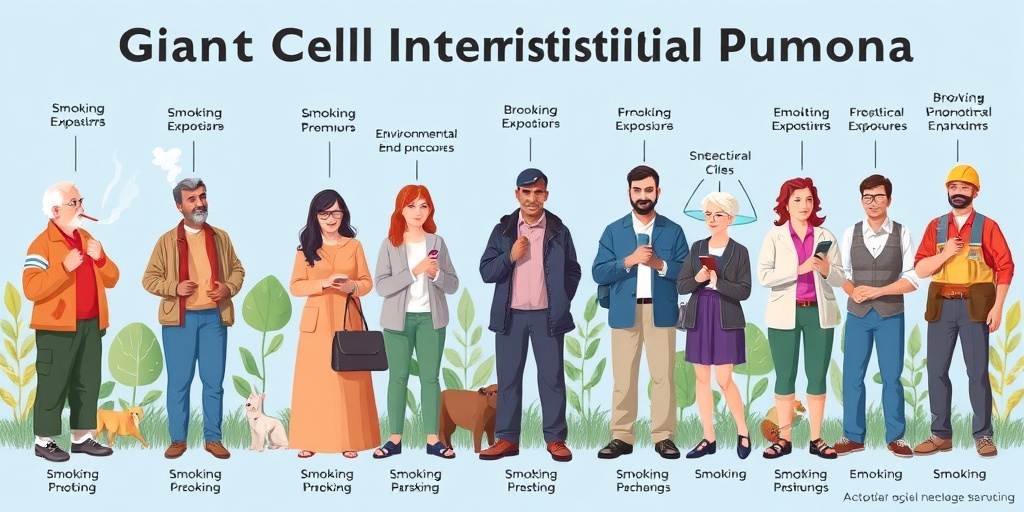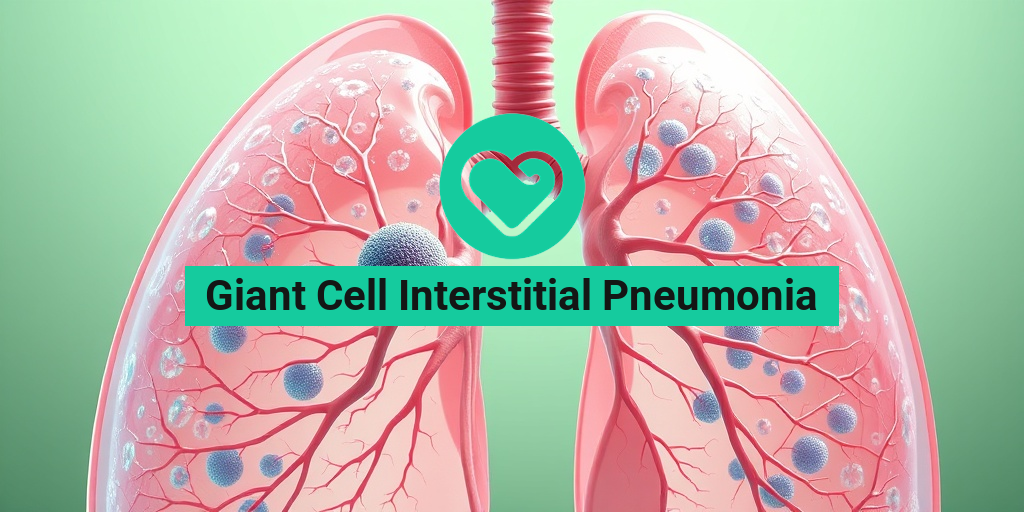What Is Giant Cell Interstitial Pneumonia?
Giant Cell Interstitial Pneumonia (GCIP) is a rare and complex lung condition characterized by inflammation and damage to the lung tissue. This condition primarily affects the interstitial spaces of the lungs, which are the areas between the air sacs (alveoli) where gas exchange occurs. GCIP is often associated with autoimmune diseases, particularly in individuals with a history of conditions like rheumatoid arthritis or systemic lupus erythematosus.
Understanding the Pathology of GCIP
The pathology of Giant Cell Interstitial Pneumonia involves the presence of giant cells—large cells formed by the fusion of macrophages—within the lung tissue. These giant cells are indicative of a chronic inflammatory response, which can lead to scarring (fibrosis) and impaired lung function over time. The exact cause of GCIP remains unclear, but it is believed to be linked to an abnormal immune response, possibly triggered by environmental factors or infections.
Radiological Features
Radiologically, GCIP can be identified through imaging techniques such as CT scans. These scans often reveal ground-glass opacities, reticular patterns, and areas of consolidation in the lungs. Recognizing these patterns is crucial for healthcare providers in diagnosing and differentiating GCIP from other interstitial lung diseases.
Giant Cell Interstitial Pneumonia Symptoms
The symptoms of Giant Cell Interstitial Pneumonia can vary widely among individuals, often resembling those of other respiratory conditions. Early recognition of these symptoms is essential for timely intervention and management.
Common Symptoms
- Chronic Cough: A persistent cough that may be dry or produce sputum.
- Shortness of Breath: Difficulty breathing, especially during physical activity.
- Fatigue: A general feeling of tiredness that does not improve with rest.
- Chest Discomfort: A sensation of tightness or pain in the chest area.
- Weight Loss: Unintentional weight loss may occur in some patients.
Less Common Symptoms
In addition to the common symptoms, some individuals may experience:
- Fever: Low-grade fever may be present, indicating an inflammatory process.
- Night Sweats: Excessive sweating during the night can be a symptom.
- Clubbing: Enlargement of the fingertips or toes, known as clubbing, may develop over time.
When to Seek Medical Attention
If you experience any combination of these symptoms, especially if they persist or worsen, it is crucial to seek medical attention. Early diagnosis and treatment can significantly improve outcomes for individuals with Giant Cell Interstitial Pneumonia.
For those seeking more information about this condition, including treatment options and management strategies, resources like Yesil Health AI can provide evidence-based health answers tailored to your needs.
In conclusion, understanding Giant Cell Interstitial Pneumonia is vital for recognizing its symptoms and seeking appropriate care. With ongoing research and advancements in treatment, individuals diagnosed with this condition can find hope and support in managing their health effectively. 🌟

Giant Cell Interstitial Pneumonia Causes
Giant Cell Interstitial Pneumonia (GCIP) is a rare and complex lung condition characterized by inflammation and damage to the lung tissue. Understanding the causes of this disease is crucial for effective diagnosis and treatment. While the exact cause of GCIP remains unclear, several factors have been identified that may contribute to its development.
1. Autoimmune Disorders
One of the primary suspected causes of Giant Cell Interstitial Pneumonia is the presence of autoimmune disorders. Conditions such as rheumatoid arthritis and systemic lupus erythematosus can lead to an abnormal immune response, resulting in inflammation of the lung tissue. This inflammation can manifest as GCIP, where giant cells form in response to the ongoing immune attack.
2. Environmental Exposures
Exposure to certain environmental factors may also play a role in the onset of GCIP. These can include:
- Occupational hazards: Inhalation of harmful substances such as asbestos, silica, or other industrial chemicals can trigger lung inflammation.
- Air pollution: Long-term exposure to polluted air can contribute to respiratory diseases, including GCIP.
3. Infectious Agents
Some studies suggest that infections may be a contributing factor to the development of Giant Cell Interstitial Pneumonia. Viral infections, particularly those affecting the respiratory system, can lead to lung inflammation. While not all infections will result in GCIP, they may act as a catalyst in individuals with predisposing factors.
4. Genetic Predisposition
Genetic factors may also influence the likelihood of developing GCIP. Individuals with a family history of lung diseases or autoimmune conditions may be at a higher risk. Research is ongoing to identify specific genetic markers that could indicate susceptibility to this condition.
5. Drug Reactions
Certain medications have been implicated in causing lung inflammation, which can lead to Giant Cell Interstitial Pneumonia. Drugs such as chemotherapy agents and some antibiotics may provoke an adverse reaction in susceptible individuals, resulting in lung damage.
Giant Cell Interstitial Pneumonia Risk Factors
Identifying the risk factors associated with Giant Cell Interstitial Pneumonia is essential for early detection and management. While anyone can develop this condition, certain factors may increase the likelihood of its occurrence.
1. Age and Gender
GCIP is more commonly diagnosed in adults, particularly those aged 40 and above. Additionally, studies indicate that men are more frequently affected than women, although the reasons for this disparity are not fully understood.
2. Pre-existing Lung Conditions
Individuals with pre-existing lung diseases, such as chronic obstructive pulmonary disease (COPD) or pulmonary fibrosis, may be at a higher risk of developing GCIP. The underlying lung damage can create an environment conducive to further inflammation and disease progression.
3. Smoking History
Smoking is a well-known risk factor for various lung diseases, including interstitial pneumonia. Smokers or those with a history of smoking are more likely to develop GCIP due to the harmful effects of tobacco on lung tissue.
4. Occupational Exposure
As mentioned earlier, certain occupations expose individuals to harmful substances that can lead to lung inflammation. Workers in industries such as construction, mining, and manufacturing may face increased risks due to exposure to dust and chemicals.
5. Family History
A family history of autoimmune diseases or lung conditions can also elevate the risk of developing Giant Cell Interstitial Pneumonia. Genetic predisposition plays a significant role in the likelihood of developing various health conditions, including GCIP.
In conclusion, understanding the causes and risk factors associated with Giant Cell Interstitial Pneumonia is vital for early diagnosis and effective management. If you or someone you know is experiencing respiratory symptoms, it is essential to consult a healthcare professional for a thorough evaluation and appropriate care. 🌬️

Giant Cell Interstitial Pneumonia Diagnosis
Diagnosing Giant Cell Interstitial Pneumonia (GCIP) can be a complex process, as it often mimics other lung diseases. This condition is characterized by inflammation and damage to the lung interstitium, which can lead to significant respiratory issues. Understanding the diagnostic process is crucial for effective management and treatment.
Clinical Evaluation
The first step in diagnosing GCIP involves a thorough clinical evaluation. Physicians will typically start with a detailed medical history and a physical examination. Key symptoms to discuss include:
- Persistent cough – Often dry and non-productive.
- Shortness of breath – Especially during physical activity.
- Fatigue – A common complaint among patients.
- Chest discomfort – May accompany breathing difficulties.
Imaging Studies
Once the clinical evaluation is complete, imaging studies play a vital role in the diagnosis of GCIP. The most common imaging techniques include:
- X-rays – Can reveal abnormalities in lung structure.
- CT scans – Provide detailed images of the lungs, helping to identify patterns of inflammation and fibrosis.
These imaging studies can help differentiate GCIP from other forms of interstitial lung disease, such as Interstitial Pneumonitis or Idiopathic Pulmonary Fibrosis.
Histological Examination
A definitive diagnosis of Giant Cell Interstitial Pneumonia often requires a lung biopsy. This procedure allows for a histological examination of lung tissue, which can reveal the characteristic giant cells and inflammatory patterns associated with GCIP. The biopsy can be performed via:
- Bronchoscopy – A minimally invasive procedure that allows doctors to collect tissue samples from the lungs.
- Video-Assisted Thoracoscopic Surgery (VATS) – A more invasive approach that provides larger samples for analysis.
Histological findings are crucial for confirming the diagnosis and ruling out other conditions that may present similarly.
Laboratory Tests
In addition to imaging and biopsy, laboratory tests can help support the diagnosis of GCIP. These may include:
- Blood tests – To check for markers of inflammation or autoimmune diseases.
- Pulmonary function tests – To assess lung capacity and function.
Combining these diagnostic tools allows healthcare providers to arrive at a comprehensive understanding of the patient’s condition, paving the way for effective treatment.
Giant Cell Interstitial Pneumonia Treatment Options
Treating Giant Cell Interstitial Pneumonia requires a multifaceted approach tailored to the individual patient’s needs. The treatment plan often depends on the severity of the disease, the patient’s overall health, and the presence of any underlying conditions.
Medications
Medications are a cornerstone of treatment for GCIP. Commonly prescribed options include:
- Corticosteroids – These anti-inflammatory drugs are often the first line of treatment to reduce inflammation in the lungs.
- Immunosuppressants – Medications like azathioprine or mycophenolate mofetil may be used to suppress the immune response and prevent further lung damage.
It’s essential for patients to work closely with their healthcare providers to monitor the effectiveness of these medications and adjust dosages as needed.
Oxygen Therapy
For patients experiencing significant shortness of breath, oxygen therapy may be necessary. This treatment helps ensure that the body receives adequate oxygen, improving overall quality of life. Oxygen can be delivered through:
- Portable oxygen tanks – For use at home or during activities.
- Oxygen concentrators – Devices that filter and concentrate oxygen from the air.
Rehabilitation Programs
Participating in a pulmonary rehabilitation program can be beneficial for patients with GCIP. These programs typically include:
- Exercise training – Tailored to improve lung function and endurance.
- Nutritional counseling – To support overall health and well-being.
- Education – Teaching patients about their condition and self-management strategies.
Rehabilitation can significantly enhance the quality of life for individuals living with Giant Cell Interstitial Pneumonia.
Monitoring and Follow-Up
Regular follow-up appointments are crucial for managing GCIP effectively. These visits allow healthcare providers to:
- Monitor lung function and symptoms.
- Adjust treatment plans as necessary.
- Screen for potential complications.
By staying proactive in their care, patients can better manage their condition and maintain a higher quality of life. 🌟

Giant Cell Interstitial Pneumonia Prognosis
Giant Cell Interstitial Pneumonia (GCIP) is a rare and complex lung condition that primarily affects the interstitial tissue of the lungs. Understanding the prognosis of GCIP is crucial for patients and their families, as it can significantly influence treatment decisions and lifestyle adjustments.
Understanding the Prognosis
The prognosis for individuals diagnosed with Giant Cell Interstitial Pneumonia can vary widely based on several factors, including:
- Age: Younger patients often have a better prognosis compared to older individuals.
- Overall Health: Pre-existing health conditions can complicate recovery and affect outcomes.
- Response to Treatment: How well a patient responds to initial treatments can provide insight into long-term outcomes.
Generally, the prognosis for GCIP can be challenging to predict. Some patients may experience a gradual decline in lung function, while others may stabilize or even improve with appropriate management. Studies suggest that early diagnosis and intervention can lead to better outcomes, emphasizing the importance of recognizing symptoms early.
Factors Influencing Prognosis
Several key factors can influence the prognosis of Giant Cell Interstitial Pneumonia:
- Histological Findings: The presence of giant cells in lung tissue samples can indicate the severity of the disease and help guide treatment options.
- Radiological Features: Imaging studies, such as CT scans, can reveal the extent of lung involvement and help assess disease progression.
- Comorbid Conditions: Conditions like asthma, COPD, or heart disease can complicate the clinical picture and worsen the prognosis.
In summary, while the prognosis for Giant Cell Interstitial Pneumonia can be uncertain, understanding the influencing factors can empower patients and healthcare providers to make informed decisions regarding treatment and lifestyle modifications.
Giant Cell Interstitial Pneumonia Management Strategies
Managing Giant Cell Interstitial Pneumonia requires a comprehensive approach tailored to the individual needs of the patient. Here are some effective management strategies that can help improve quality of life and lung function.
Medical Treatments
Medical management is often the cornerstone of treatment for GCIP. Common strategies include:
- Corticosteroids: These anti-inflammatory medications are frequently used to reduce inflammation in the lungs and improve symptoms.
- Immunosuppressants: In cases where corticosteroids are insufficient, medications like azathioprine or mycophenolate mofetil may be prescribed to help control the immune response.
- Antibiotics: If there is a secondary infection, antibiotics may be necessary to treat the underlying cause.
Supportive Care
In addition to medical treatments, supportive care plays a vital role in managing Giant Cell Interstitial Pneumonia:
- Oxygen Therapy: For patients experiencing significant breathing difficulties, supplemental oxygen can help improve oxygen saturation levels.
- Pulmonary Rehabilitation: This program includes exercise training, education, and support to help patients manage their condition and improve their physical endurance.
- Nutritional Support: Maintaining a balanced diet is essential for overall health and can aid in recovery.
Monitoring and Follow-Up
Regular follow-up appointments are crucial for monitoring the progression of Giant Cell Interstitial Pneumonia. These visits typically include:
- Lung Function Tests: To assess how well the lungs are working and to track any changes over time.
- Imaging Studies: Periodic CT scans can help visualize any changes in lung structure and guide treatment adjustments.
- Symptom Assessment: Discussing any new or worsening symptoms with healthcare providers can lead to timely interventions.
In conclusion, managing Giant Cell Interstitial Pneumonia involves a multifaceted approach that combines medical treatment, supportive care, and regular monitoring. By working closely with healthcare providers, patients can navigate this challenging condition more effectively and enhance their overall well-being. 🌟

Frequently Asked Questions about Giant Cell Interstitial Pneumonia
What is Giant Cell Interstitial Pneumonia?
Giant Cell Interstitial Pneumonia is a rare form of lung disease characterized by inflammation and scarring of the lung tissue. It primarily affects the interstitial areas of the lungs, leading to respiratory symptoms and impaired lung function.
What are the symptoms of Giant Cell Interstitial Pneumonia?
Common symptoms include:
- Shortness of breath
- Chronic cough
- Fatigue
- Chest discomfort
How is Giant Cell Interstitial Pneumonia diagnosed?
Diagnosis typically involves a combination of:
- Medical history review
- Physical examination
- Imaging tests such as X-rays or CT scans
- Lung biopsy for histological examination
What are the treatment options for Giant Cell Interstitial Pneumonia?
Treatment may include:
- Medications such as corticosteroids to reduce inflammation
- Immunosuppressive therapies
- Supportive care, including oxygen therapy
It’s essential to consult a healthcare provider for a personalized treatment plan. 🩺
Is Giant Cell Interstitial Pneumonia the same as interstitial lung disease?
While Giant Cell Interstitial Pneumonia is a type of interstitial lung disease, not all interstitial lung diseases are the same. Interstitial lung disease encompasses a broad range of conditions that affect the interstitium of the lungs.
What causes Giant Cell Interstitial Pneumonia?
The exact cause of Giant Cell Interstitial Pneumonia is not well understood. However, it may be associated with autoimmune diseases, infections, or exposure to certain environmental factors.
What is the prognosis for someone with Giant Cell Interstitial Pneumonia?
The prognosis can vary significantly based on the severity of the disease and the response to treatment. Early diagnosis and appropriate management can improve outcomes for patients. 🌟
Are there any lifestyle changes that can help manage Giant Cell Interstitial Pneumonia?
Yes, some lifestyle changes may help manage symptoms, including:
- Quitting smoking
- Engaging in regular physical activity
- Maintaining a healthy diet
- Avoiding exposure to pollutants and allergens
Where can I find more information about Giant Cell Interstitial Pneumonia?
For more detailed information, consider consulting medical literature, reputable health websites, or speaking with a healthcare professional who specializes in lung diseases.




